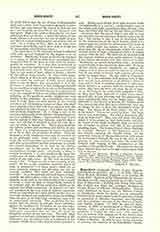
James Robert Hope-Scott
Parliamentary barrister, Q.C.; b. July 15, 1812, at Great Marlow, Berkshire, England; d. in London, April 29, 1873

Hope-Scott (originally HOPE), JAMES ROBERT, parliamentary barrister, Q.C.; b. July 15, 1812, at Great Marlow, Berkshire, England; d. in London, April 29, 1873; third son of the Honorable Sir Alexander Hope, G.C.B., who was fourth son of John, second Earl of Hopetoun, a Scottish title dating from 1703. His mother was third and youngest daughter of George Brown of Ellerton, Roxburghshire. During early childhood his home was the Military College at Sandhurst, where his father was in command. Afterwards he went abroad with his parents, staying in succession at Dresden, Lausanne, and Florence, and thus gaining a mastery of the German, French, and Italian tongues. In 1825 he entered Eton, whence, in 1828, he matriculated at Christ Church, Oxford. After a visit to Paris in 1829 he went into residence at Oxford the same year. The degree of B.A. he took in 1832, coming out in the fourth class in literis humanioribus. Next year he was elected a Fellow of Merton. In 1835 he gave up his intention of entering the ministry of the Established Church, and began to study law under conveyancers, his call to the Bar at the Inner Temple taking place in 1838. Meanwhile, in the latter year he graduated B.C.L. at Oxford, proceeding D.C.L. in 1843. In 1838, after publishing anonymously in pamphlet form a letter to the Archbishop of Canterbury, he saw through the press Gladstone’s work entitled “The State considered in its Relations with the Church“. Next year he and Roundell Palmer (the future Earl of Selborne) projected “The History of Colleges”. In 1840, at Newman’s request, Hope wrote in “The British Critic”, a review, later published separately, of Ward’s translation of “The Statutes of Magdalen College, Oxon.” The same year, as junior counsel for the capitular bodies petitioning against the Ecclesiastical Duties and Revenues Bill, he delivered the remarkably able speech which moved Brougham to exclaim, “That young man’s fortune is made.” In 1840, moreover, he was appointed Chancellor of the Diocese of Salisbury, which post he held until 1845. About the same time he took part in the foundation of Glen-almond College, in Perthshire, for the education of the Scottish Episcopal youth. In 1840-41 he spent some eight months in Italy, Rome included, in company with his close friend Edward Louth Badeley. On his return he became, with Newman, one of the foremost promoters of the Tractarian movement at Oxford. His next publication was a pamphlet against the establishment of the Anglo-Prussian Protestant See of Jerusalem, of which a second edition appeared in 1842. In 1849 and 1850 there came the Gorham trial and judgment, and in the latter year the agitation against the so-called “Papal Aggression”. These events finally determined him upon the course of joining the Catholic Church, into which, together with Archdeacon Manning, he was received in London in 1851 by the Jesuit Father Brownbill.
In 1852 he managed Newman’s defense in the libel action brought against him by Achilli, and in 1855 he conducted the negotiations which ended in Newman’s accepting the rectorship of the Catholic University of Ireland. As to Hope‘s professional work, within a few years of his call he devoted himself wholly to parliamentary practice, in which his success and emoluments became prodigious. This was the palmy period of railway construction, and eventually he became standing counsel to almost every railway in the realm. In 1849 he was appointed Q.C., with a patent of precedence.
His first wife, whom he married in 1847, was Charlotte Harriet Jane Lockhart, only daughter of John Gibson Lockhart and granddaughter of Sir Walter Scott. She soon followed her husband into the Catholic Church. A year later he became tenant of Abbotsford to his brother-in-law, and on the latter’s death, in 1853, its possessor in right of his wife, thereupon assuming the name of Hope-Scott. Not long afterwards he added a new wing to Sir Walter’s mansion. In 1855 he bought the Highland estate of Dorlin, whereon he built a new house, selling the whole to Lord Howard of Glossop in 1871. In 1858 he had to mourn the loss of his wife, who died in childbed, the newborn child dying shortly after, and Walter Michael, his infant son and heir, before the close of the year. His second wife, whom he wedded in 1861, was Lady Victoria Alexandrina Fitzalan-Howard, eldest daughter of the fourteenth Duke of Norfolk, of whose children Hope-Scott had been left guardian. In 1867 he had the honor of a visit from Queen Victoria at Abbots-ford, and in the same year he bought a villa at Hyeres, in Provence. Like her predecessor, his second wife died in childbed in 1870, after giving birth to James Fitzalan Hope, now (1909) M. P. Hope-Scott never overcame the grief and shock entailed by this last bereavement. He now withdrew from his profession, surviving his dead wife but little more than two years, and dying in 1873. His funeral sermon was preachedby his old and intimate friend Cardinal Newman in the same Jesuit church of Farm Street in which, two and twenty years back, Hope-Scott had made his submission to the Catholic Church. His charities and benefactions were wellnigh boundless. It is reckoned that from 1860 onwards he spent £40,000 in hidden charity. Among his innumerable good works, he built at a cost of £10,000 the Catholic church at Galashiels, near Abbotsford, and he was the chief benefactor of St. Margaret’s Convent, at Edinburgh, wherein he lies buried.
C. T. BOOTHMAN

